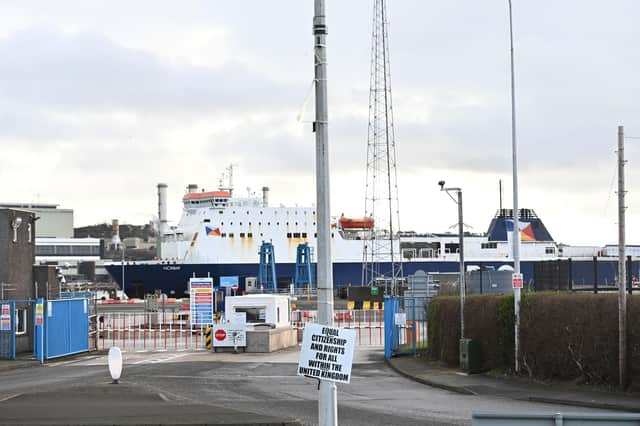Esmond Birnie: Covering protocol costs as it stands will not be sustainable


This aspect of the protocol has received surprisingly little attention. It was one of the points I included in my written submission to the House of Lords’ sub-committee on the protocol’s call for written evidence.
A lack of interest in the public spending aspect of the protocol will get harder to sustain in a climate of renewed austerity.
Advertisement
Hide AdAdvertisement
Hide AdThe main category of spending has been the Trader Support Service (TSS). TSS has helped businesses with the process of filling in the forms, particularly with respect to customs declarations.
A recent parliamentary answer revealed that about £170m was spent running the TSS in each year 2021 and 2022.
Further information and help relating to food products coming from GB is provided through the Movement Assistance Scheme (MAS) and increasingly through the Digital Assistance Scheme (DAS) (administering those food products digitally).
The National Audit Office (NAO, November 5, 2021) estimated that funding to the MAS would amount to £200m over the three years 2021-2023; about £65m annually.
Advertisement
Hide AdAdvertisement
Hide AdThe UK government estimated that £150m would be needed to develop the DAS (in the command paper on protocol policy in July 2021).
These relatively large sums of spending partially mitigate the costs the protocol imposes on businesses.
A further type of public spending is associated with the actual implementation of the protocol: notably, vet and other checks at ports in Northern Ireland.
In February 2022 the Agriculture (DAERA) Minister Edwin Poots gave a sum of about £8.7m for such costs in 2021.
Advertisement
Hide AdAdvertisement
Hide AdSo, in grand total the total public expenditure cost of the protocol has been about £250m annually in the first two years of its operation.
There are indications that some of the components of that total are declining: the spending on TSS. However, other components are likely to increase over time, e.g. the MAS/DAS.
So, we cannot be at all confident that the total public expenditure cost of about £250m will decrease in the future.
How should we react to this situation:
l It would be unacceptable to say, “it doesn’t matter to us because all this funding is coming from the UK Treasury”. This would be a new form of the “free money” fallacy which helped cause the RHI crisis in the mid 2010s.
Advertisement
Hide AdAdvertisement
Hide AdEfficiency and effectiveness matter for all forms of public spending regardless of where the funding ultimately comes from. Also, this liability that is currently being picked up the UK government could easily shift in the future to either the NI public sector or the NI private sector.
l From an everyday and absolute point of view £250m annually is a big sum of money. Admittedly, it is a drop in the bucket compared to total UK public expenditure of about £1000bn every year.
However, consider the public spending “cost” of the protocol compared to the total size of the NI economy (about £50bn) and it amounts to about half a percentage point.
If the protocol were imposing a public expenditure cost equivalent to 0.5% of the entire UK economy that would represent about £10bn, which gives some sense of the scale.
Advertisement
Hide AdAdvertisement
Hide Adl The £250m annual public spending to mitigate the protocol has “worked” to the extent that it, along with the extensive grace period exemptions, creates a sort of equilibrium.
Things have settled down and we have a situation which whilst bad for some businesses is tolerable or profitable for some others. But it is a false equilibrium because if the UK government funding is removed something else would have to give.
Either the burden of form filling etc would be shifted entirely on to the private sector or the £250m would have to come off the NI public expenditure block.
l There has been quite a lot of narrative about how a large part of NI business have been doing reasonably well under the protocol or even (allegedly) that the economy overall has outperformed the UK average.
Advertisement
Hide AdAdvertisement
Hide AdIF this narrative were taken at face value one response could be to say “let’s test this by seeing what would happen if the £250m of public expenditure support were removed”. Of course, this might be a rather hazardous course to adopt given that in reality the NI economy has not been doing that well compared to the UK average since the protocol began in January 2021.
Also, whilst the protocol has certainly helped some businesses (those selling to the Republic of Ireland and the rest of the EU) it has imposed major costs on those relying on inputs coming from GB and those are the very firms which would suffer further if the TSS/MAS/DAS stopped.
l Whatever agreement the UK government and EU may, or may not, be heading towards in the current negotiations on the protocol it will not be sustainable if it relies on a considerable annual public subsidy to prop it up, in the manner that the current arrangements do.”
l Dr Esmond Birnie is senior economist at Ulster University Business School
l Ruth Dudley Edwards will return next week